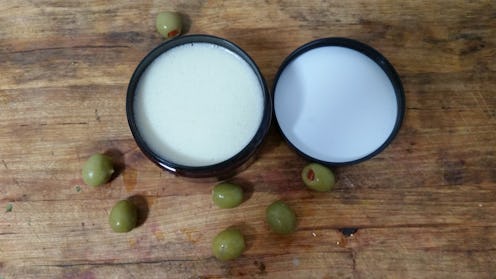
Since I moonlight as a bartender, my hands see far more wear and tear than the rest of my bod. One of my favorite ways to keep my hands as smooth as the rest of me is to make a homemade olive butter to restore moisture and heal the woes a 10 hour shift leaves on my hands — woes that range from nicks and cuts from broken glass to excessively dry hands from cleaning products and washing glassware.
Olive butter makes for an excellent moisturizer because it's an emollient that is heavy enough that it stays put even when you wash your hands. According to Livestrong, infusing butter with olive oil can increase moisture and more importantly, lock in moisture so you can better protect your hands. Contrary to popular belief, the olive butter you buy in stores isn't made from pressing olives. Instead, it's typically shea butter infused with olives, which is what gives it such a thick texture. This texture can feel greasy at first, but if you apply on damp hands and wait a few moments, you'll see the butter begins to settle in your hands, leaving your hands feeling silky smooth.
While those of us who work with our hands tend to face an upward battle of moisture loss, it's fairly common for hands to need a little more TLC than the rest of your skin, regardless of your industry. According to the Huffington Post, our hands are the most exposed to elements like the sun and wind, so they really take a beating. Fortunately, a DIY olive butter can give your hands long-lasting moisture for those times it feels like you've been literally on your hands all day long.
One of my first jobs was as a barista and my cozy coffee counter was directly across from the Body Shop. This was my first experience with body butters and the start of my excessive dry hands. While olive butter is not hard to find on the shelves, I find that it's cheaper and a lot more fun to make my own. Plus, going the DIY route means you can add your own essential oils of choice. Here's how to do it.
1. Pick A Base
Shea butter is a great choice for turning your olive oil into a fantastic butter, but there are plenty of other butters out there that can restore moisture in your skin and have a long-lasting effect. I also like to use kokum butter, which seeps into the skin faster or mango butter which fights against UV damage. If you're overwhelmed by your butter choices, blend two together!
2. Blend Together
To give your butter that store-bought consistency you so desire, I recommend adding extra virgin, unrefined olive oil to your raw butter of choice in a blender rather than trying to mix by hand. Turn it on until it's reached a smooth consistency and uncover.
Don't be surprised if your butter isn't bright green! Some OTC olive butters add extra coloring to make the butter greener, but it doesn't add to the butter's efficacy.
3. Choose Your Essential Oils
Some essential oils work better on dry skin than others. While you can still benefit from your olive butter by adding your favorite smelling oils, you should do a quick search to see which ones will really amp up your butter in the way you see fit. Lavender, chamomile, geranium, and cedarwood will all be soothing on dry skin.
4. Mix It Up
Now that you've decided on your essential oils, add several drops in the blender where your mixed up butter has been chilling. Since my first batch was being made for a pal suffering from a mild form of eczema on his hands, I added about seven drops of pine, 10 drops of juniper, and eight drops of cedarwood essential oil.
5. Store Properly
Store your new olive butter in a tinted, sealable container for future use. I like to keep a big one on my nightstand (so I can remind myself of how dry my hands probably are when I go to sleep) and a tiny one in my purse for midday touch-ups. If your butter is in a tinted container, you'll use it all up before it goes bad. Those essential oils can be natural preservatives, so there is no need to store in your fridge!
Image: Kristin Collins Jackson (8)